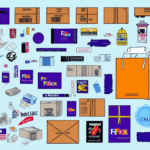What Are the New UPS Hazardous Shipping Rates?
If you are involved in the transportation of hazardous goods, it is crucial to stay updated with the latest regulations and pricing updates. Recently, UPS has introduced new hazardous shipping rates that significantly impact businesses utilizing their services. This article provides an in-depth analysis of the new UPS hazardous shipping rates, the associated regulations, and their implications for businesses.
Understanding the Hazmat Shipping Regulations
Hazmat shipping regulations are established to ensure the safe and secure transportation of dangerous goods. The US Department of Transportation (DOT) regulates hazmat transportation to minimize the risk of accidents and protect the public and the environment from hazardous materials. These regulations encompass all transportation modes, including air, sea, and land. As a hazmat carrier, UPS must comply with these stringent regulations.
It is important to note that hazmat shipping regulations apply not only to businesses but also to individuals shipping such materials. Non-compliance can result in hefty fines and legal consequences. Proper labeling, packaging, accurate documentation, and training for those handling hazardous materials are essential. Adhering to these regulations ensures the safety of everyone involved in the transportation process.
UPS Hazmat Shipping: A Comprehensive Overview
UPS offers a range of solutions for shipping hazardous materials, including specialized shipping containers, labeling, and documentation to ensure regulatory compliance. Their trained personnel are equipped to handle hazardous goods and provide guidance on proper handling and transportation.
However, not all hazardous materials can be shipped through UPS. Certain materials, deemed too dangerous for air transportation, may require alternative shipping methods. Additionally, some hazardous materials necessitate special permits or approvals before shipping. Proper identification and classification of hazardous materials are crucial to ensure safety and compliance during transportation.
Key Changes to the UPS Hazardous Shipping Rates
Effective September 13, 2021, UPS introduced new hazardous shipping rates. The primary update involves the UPS Hazardous Materials Service charge, applicable to packages containing hazardous materials across all UPS services, including Ground, Air, and International. The new rates are determined based on the type and quantity of hazardous materials being shipped.
In addition to revising the service charge, UPS has updated its list of hazardous materials subject to shipping restrictions. This updated list includes items such as lithium batteries, flammable liquids, and explosives. Shippers must review this list to ensure compliance with all regulations before shipping hazardous materials with UPS. Non-compliance can lead to fines, penalties, and potential harm to individuals and the environment.
Impact of the New UPS Hazardous Shipping Rates on Your Business
The revised hazardous shipping rates will affect businesses transporting hazardous materials via UPS. Rates vary depending on the hazardous material category, quantity, and the chosen service. Understanding your shipping needs and assessing the financial impact of these changes is essential for businesses.
Businesses can mitigate the impact of the new rates by reviewing current shipping practices to identify opportunities for consolidation. Combining multiple hazardous shipments into a single shipment can reduce overall shipping costs. Additionally, exploring alternative shipping methods, such as ground transportation, may offer more cost-effective solutions for certain hazardous materials.
Staying informed about changes in hazardous materials regulations is also vital. UPS provides resources and training to help businesses comply with regulations and avoid potential fines or penalties. By staying proactive and following proper procedures, businesses can ensure the safe and efficient transportation of hazardous materials while minimizing costs.
Best Practices for Shipping Hazardous Materials with UPS
The safe transportation of hazardous materials requires specialized knowledge, training, and equipment. UPS offers comprehensive guidance to ensure compliance with regulations and safe transportation practices. Key best practices include:
- Proper Packaging: Use UN-certified packaging designed for specific hazardous materials.
- Accurate Labeling: Ensure all packages are correctly labeled with the appropriate hazardous material labels.
- Comprehensive Documentation: Maintain accurate shipping documents that detail the nature and quantity of hazardous materials.
- Employee Training: Ensure that all employees handling hazardous materials are adequately trained and qualified.
- Choosing the Right Service: Select the appropriate UPS hazardous shipping service based on the material and shipping requirements.
Certain hazardous materials may require additional permits or approvals before shipping. It is the shipper's responsibility to obtain these permits. UPS can provide guidance on the necessary permits and approvals needed for specific hazardous materials. Regularly reviewing and updating hazardous materials shipping procedures is also essential to maintain compliance with evolving regulations and industry standards.
Comparing UPS Hazardous Shipping Rates with Other Carriers
When shipping hazardous materials, comparing rates and services from different carriers is essential. Besides UPS, other carriers like FedEx and DHL offer hazardous shipping services. Comparing rates, services, and carrier reputations helps businesses make informed decisions.
Consider the following factors when comparing hazardous shipping rates:
- Insurance Coverage: Evaluate the level of insurance coverage each carrier provides for hazardous materials shipments.
- Transit Times: Assess the transit times offered by each carrier, especially for time-sensitive shipments.
- Customer Support: Look for carriers that offer 24/7 customer support and have dedicated teams for hazardous materials shipments.
By carefully evaluating these factors, businesses can select the carrier that best meets their hazardous shipping needs while ensuring safety and compliance.
Calculating Your Hazmat Shipping Costs with UPS
Calculating the cost of shipping hazardous materials with UPS involves several factors. UPS provides tools like the UPS Hazmat Rating Tool to assist businesses in determining appropriate shipping services, applicable charges, and relevant regulations.
Factors influencing the cost of hazmat shipping include:
- Type of Hazardous Material: Different materials have varying shipping costs based on their classification and handling requirements.
- Quantity: Larger quantities of hazardous materials typically incur higher shipping costs.
- Destination: Shipping costs vary based on domestic or international destinations.
- Mode of Transportation: Shipping via air may be more expensive than ground transportation due to stricter regulations and safety requirements.
In addition to using the UPS Hazmat Rating Tool, businesses can consult with UPS experts to ensure compliance with all applicable regulations and requirements. UPS offers training and consulting services to help businesses navigate the complexities of hazardous materials shipping, ensuring safe and timely deliveries.
Navigating Hazmat Paperwork with UPS
The paperwork involved in hazmat shipping can be complex and overwhelming. UPS provides comprehensive guidance on required documentation, including shipping papers, manifests, and labels. Utilizing tools like the UPS WorldShip® software can streamline the creation and printing of necessary paperwork.
Regulations for hazmat shipping can vary by country and even by state or province within a country. UPS employs a team of experts who stay current with these regulations and offer guidance to ensure compliance. Additionally, UPS provides hazmat training courses for employees handling hazardous materials, ensuring they are properly trained and equipped to manage shipments safely.
UPS also offers specialized hazmat packaging solutions to ensure hazardous materials are appropriately contained and labeled during shipping. These solutions include UN-certified packaging, absorbent materials, and temperature-controlled packaging for materials requiring such conditions. Utilizing these specialized packaging solutions helps businesses ensure compliance with regulations and the safe arrival of their hazmat shipments.
Avoiding Common Hazmat Shipping Mistakes with UPS
Non-compliance with hazardous shipping regulations can result in fines, legal sanctions, and environmental harm. Common mistakes when shipping hazardous materials include:
- Failing to properly classify materials
- Using incorrect packaging
- Improper labeling or documentation
- Incorrect handling or disposal of materials
UPS offers training and guidance to help businesses avoid these common mistakes. Properly training employees who handle hazardous materials is critical. This training should cover correct packaging, labeling, documentation, and safe handling and disposal practices.
Furthermore, UPS provides a variety of hazmat shipping services to assist businesses in complying with regulations and avoiding errors. These services include hazmat packaging and labeling, document preparation, and the transportation of hazardous materials. Utilizing these services ensures that hazardous materials are shipped safely and in compliance with all regulations.
Packaging and Labeling Hazardous Materials for UPS
Proper packaging and labeling of hazardous materials are essential for safe transportation. UPS provides detailed guidance on specific packaging and labeling requirements for hazardous materials. Key guidelines include:
- Using UN Performance-Oriented Packaging designed for the specific type of hazardous material.
- Properly labeling all hazardous materials with the appropriate markings, including hazard class labels and handling instructions.
- Ensuring that packaging is sealed and secured to prevent leaks or spills during transit.
Adhering to these packaging and labeling standards is crucial for compliance and ensures that hazardous materials are transported safely and efficiently.
Tips for Ensuring Safe and Compliant Hazmat Shipping with UPS
Ensuring safe and compliant hazmat shipping is vital for businesses handling hazardous materials. UPS recommends the following tips to achieve this:
- Employee Training: Provide comprehensive training for employees handling hazardous materials to ensure they understand safety protocols and regulatory requirements.
- Regular Safety Audits: Conduct periodic safety audits to identify and address potential compliance issues or safety hazards.
- Accurate Documentation: Maintain detailed and accurate shipping documentation to ensure compliance with regulations and facilitate smooth transportation.
- Proper Equipment: Invest in appropriate equipment and specialized transportation vehicles designed for hazardous materials to enhance safety and compliance.
Implementing these practices helps businesses maintain compliance, enhance safety, and ensure the efficient transportation of hazardous materials.
The Future of Hazmat Shipping with UPS: Trends and Predictions
The future of hazmat shipping is evolving alongside increasing environmental concerns and technological advancements. Businesses can expect changes in regulations, packaging innovations, and transportation methods to address these trends. Key future developments include:
- Enhanced Environmental Regulations: Stricter environmental regulations aimed at minimizing the impact of hazardous materials transportation.
- Advanced Packaging Technologies: Development of more durable and sustainable packaging solutions to improve safety and reduce environmental footprint.
- Automation and Digitalization: Increased use of automation and digital tools to streamline hazmat shipping processes, improve accuracy, and enhance compliance.
- Sustainable Transportation Methods: Adoption of greener transportation methods to reduce carbon emissions and promote sustainability in hazmat shipping.
UPS is committed to staying abreast of these changes and providing businesses with safe, efficient, and compliant hazmat shipping solutions that align with emerging trends and regulatory requirements.
Finding Help and Resources for Hazmat Shipping with UPS
If you need assistance with hazmat shipping, UPS offers a variety of resources to support your needs. These resources include:
- Customer Service: Dedicated customer service teams available to answer questions and provide guidance on hazmat shipping.
- Online Hazardous Materials Information Center: An online resource offering detailed information on hazmat regulations, shipping requirements, and best practices.
- Specialized Training Programs: Comprehensive training programs designed to educate employees on the safe and compliant transportation of hazardous materials.
Utilizing these resources ensures that your hazmat shipping processes are compliant, safe, and efficient.
Conclusion: Are the New UPS Hazardous Shipping Rates Worth It?
The new UPS hazardous shipping rates may initially seem daunting, but they are essential for ensuring the safe and compliant transportation of hazardous materials. These rates are based on the type and quantity of hazardous materials being shipped and reflect the costs associated with providing specialized packaging, labeling, and documentation.
Businesses involved in transporting hazardous materials must prioritize compliance with regulations and proper handling of these materials to avoid fines and ensure public and environmental safety. The updated UPS hazardous shipping rates are a necessary investment that supports these objectives, ensuring that hazardous materials are transported safely and responsibly.






















